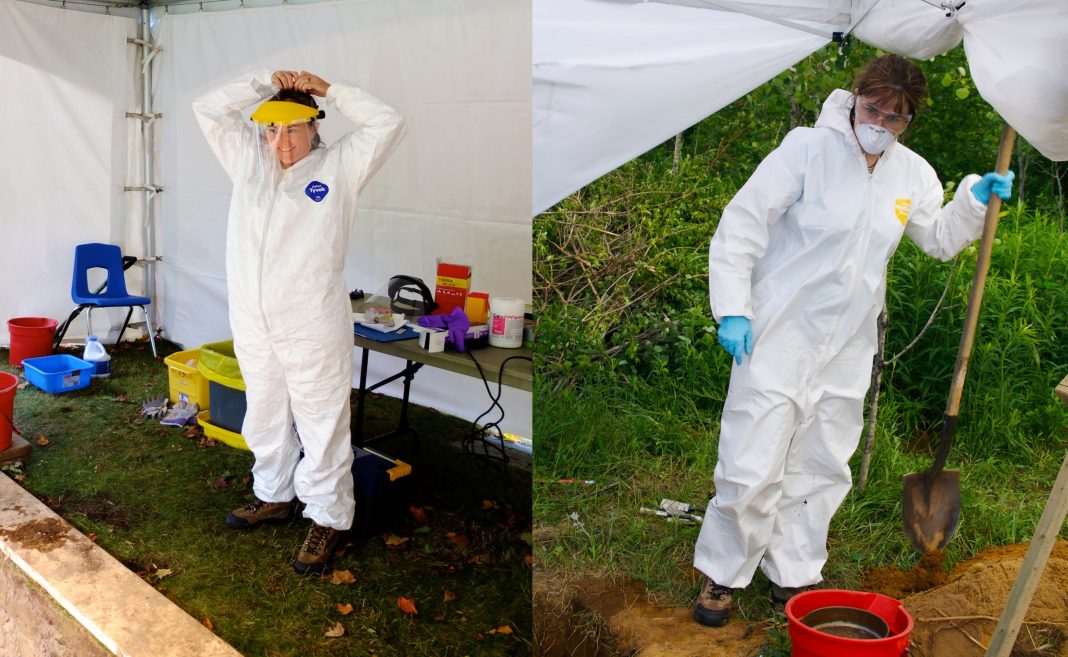It’s a dark evening. The smell of rain is heavy in the air. She walks along a newly put-down trail behind a townhouse complex. Suddenly, she steps on something that feels distinctly brittle and dense. Curious, she looks down. With the dim light of the moon, it’s hard to tell, but she is able to discern what seems to be the remains of a human skull.
This story is not a mere tale, but rather a true story retold by Professor Tracy Rogers. The image of unknowingly coming across the remains of what once used to be a living person is frightening. While we hope not to be the ones to discover human remains, it does happen.
Professor Tracy Rogers is the director of Forensic Sciences at UTM. She is a forensic anthropologist and has done casework for the Ontario Forensic Pathology Service, the British Columbia Coroners Service, the Royal Canadian Mounted Police, and other police agencies in British Columbia and Ontario. She was also the primary forensic anthropologist in the case of Canadian serial killer Robert Pickton.
On February 2, Dr. Rogers gave a Lecture Me! presentation on the process of going through human remains. Lecture Me! is a multidisciplinary series presented every month by a UTM professor from a different faculty. The events are hosted virtually by the Mississauga Library System through their Virtual Library Webex platform typically on the first Tuesday of each month from 7 p.m. to 8:15 p.m. Each presentation features a different UTM faculty member delivering their presentation to the community about their research.
During her presentation, Dr. Rogers took participants through the process of uncovering and identifying human remains. She began by explaining how remains are discovered in the first place. While there are organized searches that help find missing persons, most of these discoveries are usually accidental. As Dr. Rogers put it, “Every time you turn around, it’s always two kids on a bike that find human remains.”
Once these remains are found, the next step in the process is to determine if these remains are even human at all. Dr. Rogers explained how sometimes what we believe are human remains are actually animal bones or may not be bone at all. In her Lecture Me! event, Dr. Rogers incorporated an interactive activity in which she showed pictures, and participants had to guess whether or not the object in the photo was bone or not. Then participants predicted whether it was human or animal bone.
Another important aspect of processing human remains is determining their medical-legal significance. Despite popular belief, Dr. Rogers said, “Not everything is of medical-legal concern. In some cases, bones end up in strange places by accident.” For example, in Dr. Roger’s personal story, the skull was in the dirt of the trail because that dirt was ordered from a cemetery—making the human remains of no medical-legal significance.
To examine the medical-legal significance of human remains, Dr. Rogers stated that there are three thins to look for. The first thing that needs to be assessed is the context. This means forensic anthropologists must look at where and in what state the bone was found. Dr. Rogers provided the example of finding human remains close to a cemetery. If there was disturbed ground near the cemetery, then “this would be the sort of context that would leave us to believe that these remains are associated with the cemetery,” which is something that needs to be kept in mind when further analyzing the scene.
The next factor in determining medical-legal significance is inspecting the condition of the bone. For example, if we carry on with the idea of a cemetery bone, then “we expect to see something that is pretty dry and brittle.” This gives forensic anthropologists a greater idea of the age and origin of a bone. The last factor that forensic anthropologists examine is the artifacts found near the bone. Dr. Rogers describes this as contextual cues “associated with these remains.” Following along with the cemetery example, this could be coffin hardware or embalming artifacts.
Once medical-legal significance is determined, forensic anthropologists must identify the body. Dr. Rogers explained that “our way of doing that is [to] first create a biological profile, […] which includes the sex of the individual, the age, and the ancestry.”
Biological profiles are an essential part of the process because not everyone in the province has a DNA file on the registry. Additionally, there are more than 7,000 missing adults in Ontario, which means the process must be streamlined. This is done by formulating a biological profile. If forensic anthropologists can narrow down the sex, age, and ancestry of the individual, it helps narrow down the list of 7,000 people and to solve any new cases.
Studying human remains is not always the easiest thing. It is often difficult to look at a deceased person from a clinical and objective standpoint. Studying what used to be someone’s loved one is a challenging reality for forensic pathologists. But this vital work helps bring closure to families, communities, and friends.
Dr. Rogers highlighted the importance of her work perfectly by saying: “The reason that we study the dead is to learn from it and protect the living.” What is learned by forensic anthropologists and coroners offices are used to conduct research, educate the public, and establish more effective methods to deal with human remains in future cases. Dr. Rogers emphasized that it is essential that all pieces used in the examinations are treated with respect because each piece of evidence once belonged to a living person—one who cannot be forgotten.
Readers can sign up for future Lecture Me! events on the UTM Experiential learning website. These events are opened to anyone. The next presentation, “How Cooking is Art,” will occur on March 2 and will feature UTM philosophy professor Mohan Matthen.



